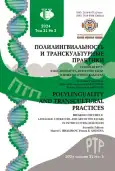Djinn in Turkish and Tatar Culture: The Invisible Neighborhood
- Авторлар: Davletshina L.K.1
-
Мекемелер:
- G. Ibragimov Institute of Language, Literature and Art Academy of Sciences of the Republic of Tatarstan
- Шығарылым: Том 21, № 3 (2024): BREAKING THE CIRCLE: LANGUAGE, LITERATURE, AND ART OF THE TATARS IN INTERCULTURAL DIALOGUES
- Беттер: 591-600
- Бөлім: CULTURE AND ART
- URL: https://journal-vniispk.ru/2618-897X/article/view/326925
- DOI: https://doi.org/10.22363/2618-897X-2024-21-3-591-600
- EDN: https://elibrary.ru/POMCPM
- ID: 326925
Дәйексөз келтіру
Толық мәтін
Аннотация
The jinn as a mythological character, whose roots go back to the Muslim tradition, is widely spread in the culture of the peoples professing Islam, and does not lose its relevance to this day. This article examines the models of the relationship between jinn and humans in Turkish and Tatar culture in the aspect of the neighborhood category. Main tasks: to summarize the available representative material about jinn in Turkish and Tatar folklore, to compare a set of ideas about the main characteristics of the jinn in both cultures, to consider the practice of relationships between jinn and humans. As a result of the conducted research, it was revealed that the models of relationships between representatives of people and their invisible neighbors in Turkish and Tatar culture are largely based on similar semantic elements: jinns are omnipresent, easily violate borders and penetrate into the human world, harm people, which leads to the emergence of a system of prohibitions and ritual practices that echo sociocultural models of communication in society. However, the degree of regulation of behavior between djinn and humans has its own national specifics in each culture under consideration.
Авторлар туралы
Leila Davletshina
G. Ibragimov Institute of Language, Literature and Art Academy of Sciences of the Republic of Tatarstan
Хат алмасуға жауапты Автор.
Email: leyla.davletshina@yandex.ru
ORCID iD: 0000-0002-1222-957X
SPIN-код: 6333-5552
Doctor of Philology, Leading Researcher of Folk Art Department
20 Bauman St, Kazan, 420111, Republic of Tatarstan, Russian FederationӘдебиет тізімі
- Bogdanova, E., Brednikova O., and O. Zaporozhets. 2021. “How to understand and explore the neighborhood?” Laboratorium: Journal of social research, vol. 13, no. 2. pp. 139–171. https://doi.org/10.25285/2078-1938-2021-13-2-139-171.
- Trofimova, K.P., and A.A. Yarlykapov. 2022. “Invisible neighbors and visible neighborhood: jinn and people in Muslim cultures (introduction to the special topic of the issue).” Siberian Historical Research, no. 3, pp. 6–13. https://doi.org/10.17223/2312461X/37/1.
- Grinberg, S.A. 2023. “Ambivalence of the image of fire in Belarusian national culture.” Polylinguality and Transcultural practices, vol. 20, no. 4. pp. 627–635. https://doi.org/10.22363/23128127-2023-20-4-627-635.
- Basharin, P.V. 2019. “The image of jinn in Muslim magic.” In Umbra: demonology as a semiotic system: almanac. Composed by O.B. Antonov. Moscow: RSUH publ., pp. 106–141. Print. (In Russ.)
- Nalich, T.S. 2009. Angels and other supernatural beings in Islam. Moscow: Znak publ. Print. (In Russ.)
- Günther, S., and D. Pielow. 2018. Magie in arabischen Quellen und in der Forschungsliteratur. Leiden; Boston; Cologne: E.J. Brill.
- Küçükyildiz Gözelce, D. 2022. “Türkiye sahasi efsane ve memoratlarında cin tasavvuru/” Kafkas Üniversitesi Sosyal Bilimler Enstitüsü Dergisi, vol. 30, pp. 719–757. https://doi.org/10.56597/kausbed.1165458
- Tatar halyk iҗaty: 25 tomda. 2021. Kazan: Tatar. whale. nəshr. 1 volume: Mythology. Kazan. Print. (In Tat.)
- Myths of the peoples of the world: Encyclopedia: In 2 volumes. 2003. Vol. 1. Edited by S.A. Tokarev. Moscow: Great growth publ.
Қосымша файлдар









